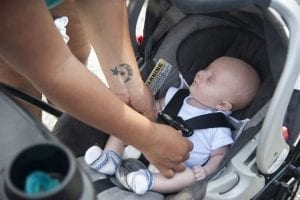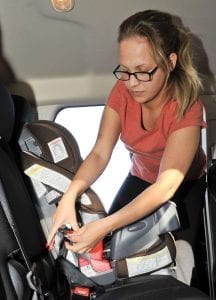Your baby’s safety on the road should be a top priority at all times, wherever you go. Thus, all parents need the best baby car seats with the best safety features to offer. Want to know how to pick the best baby car seat? And do you know what safety features to look for in infant seats and not just follow the baby trend?

Here is some advice from experts from the American Automobile Association (AAA).
Considerations Before Buying The Best Infant Car Seats
According to the report of the National Highway Traffic Safety Administration (NHSTA), 2000 children under 14 were nearly killed, while over 230,000 got injured due to motor vehicle crashes in 2005. These injuries vary from a head injury to musculoskeletal injuries. Indeed, these facts and figures raise the alarm and worries among the parents who take their children on car rides. Still, awareness and prevention can always minimize the possible impacts of these accidents on your family. That’s why it is essential to choose the perfect car seat with the right safety features and passed crash test results as an appropriate seat for your child’s age and size, ensuring you have the right seat for your new baby.
Although it may be cheap, getting a used car seat for your baby is not recommended. Also, keep in mind that installing baby carriers properly can keep your baby safe during the trip or even in times of mishaps. It won’t matter if you have the most ideal baby car seat or a used car seat because if it is not installed correctly, then it will not perform as designed. Here are eight helpful tips that you can consider when choosing the right infant car seat for your child and what safety features to consider.


1.Best Consult The Vehicle’s Manual
Choosing a suitable infant car seat is not easy as baby carriers have distinct safety features, whether generic for all vehicles or specific for the brand you have. Some are equipped with a load leg, anti-rebound bar, and adjustable headrest, while some are not. Because of this, you must first review the owner’s manual to boost your insights and considerations about what to buy, its suitability to your car’s attributes, and how to install correctly after. After all, the product you’ll purchase should be satisfying not only to your kid’s safety but also to your appeal and taste.
Before buying, decide first what you want to use for your baby and how you want to affix the seat in your car or relative’s car. There are two ways to attach an baby car seat: regular seat lap belt and LATCH system. The seat belt system is used to fasten infant car seats in an old-fashioned way. This system has been becoming a trend for new vehicles. If you decide to use the LATCH system, make sure that your car has proper latch attachments, especially in the middle and rear carriers, which are the safest spots in the car. Rear-facing baby carriers are installed using your vehicle’s seat belt.
There are also baby carriers that are built into the car directly, which is called an integrated car seat. Also, it is important to know if your car has a bucket seat. A bucket high-end seat can prevent your baby carrier from getting installed properly and would require a narrower car seat base.
Even the Child Passenger Safety technicians read the manual of vehicle owners for proper installation instructions, as noted by Greg Billings, who is a Child Passenger safety technician from Chico, California. Recommended by the American Academy of Pediatrics (AAP), the CPS promotes and supports optimal safety for children and adolescents of all ages during all forms of travel (Durbin and Hoffman, 2018).
2. Check The Vehicle Seats That Best For Your Child’s Age, Including The Height And Weight Limit
The owner’s manual also discusses the details of the height and weight limit of the baby car seat you bought. You must check if the additional body statistics of your baby will still be suitable for the safety features of your vehicle. The American Academy of Pediatrics encourages the usage of age-appropriate carriers for children. Here are some of its general guidelines to help you get the right one from the list of some of the best infant car seats options in the industry.


Rear-facing infant seats:
This is the perfect car seat for newborns and infants; the AAP recommends the usage of this type of baby car seat for children for as long as their height and weight limits still satisfy the same safety standards. This principle outdates the old belief that your kid is old enough for the facing forward seat when he/she is already 12 months old and reaches 20 pounds. Remember: it’s all about the height and weight limits! Most rear-facing carriers are installed using the vehicle’s seat belt and come with a load leg.
Forward-facing Seat:
This baby car seat is suggested for children aged at least two years old or when they have met the maximum height or weight limit of the vehicle seat. Your kids have ideally outgrown the forward-looking carriers if the middle of their heads, shoulders, or ears are above the seat.
Booster Seat:
Your children should be over 40 pounds for them to use this type of baby car seat. But as soon as they reach around eight years old, your kids may already be ready to use the adult seat belt (without the booster) at the back seat of the vehicle (not at the front seat!). Just make sure that the seat belt fits their shoulders and laps perfectly.
3. Know How Much Room You Have In The Back Part Of The Vehicle
A baby car seat with a broad seat base may not fit in small cars; you may have to opt for one with a narrower seat base or a compact vehicle seat with tight fit instead which may allow three car carriers if needed.


The size of your baby vehicle seat should match the dimensions of your car’s seat to maintain comfort and security. This is especially important for those with small cars. Assign the family members who will regularly use the back seat, and make sure that there is still enough space for the additional child seat. Initially, measure the length of your car’s back seat before going shopping. Bring a measuring tape when you go to the store to measure the base of the infant car seats you’re checking out, keeping in mind the length of your back seat. For a higher chance of fitting, purchase the one with a narrower base which is good for small cars.
4. Make Installation Easy
The infant car seat itself should have clear instructions. Choose one that explains installation with diagrams and text. Installation should be easy for most of the best infant car seat options.
Another factor to consider in choosing the best infant car seat for your baby is the comprehensiveness of its instruction manual. You should be able to understand the directions and procedures easily, and the diagrams should help you install and use the product correctly. Remember that even most carriers have different designs, sizes, and compatibility. Thus, you need to understand the specifications, and the manual must be clear for you to follow. There are 2 ways to install a baby seat in the vehicle – using the seat belt or the LATCH system. Most rear-facing car seats are installed using a seat belt and they come with a load leg and anti-rebound bar for extra body support. A baby carrier should be in recline positions at 45 degrees for babies who are still too young and unable to control their head and neck. Consider these details as you shop for the right baby seat.


A tip for expectant parents? Install the baby vehicle seat way ahead before the baby is brought home from the hospital. This lessens the hassle and anxiety felt by the parents of the newborn.
If you’re not confident enough with the way you have installed your baby car seat, don’t hesitate to reach a CPS technician in the nearest area to assist you. A CPS technician is an expert when it comes to baby car seats and the proper way to install them. It always pays off to be sure because it’s your kid’s safety that’s at risk. It is not enough to choose from the top infant vehicle carriers, as proper installation is equally important.
5. Check Belt Path
Make sure it is accessed easily and the seat belt is fastened and secure. Follow the belt path of the safety seat if you wish to install it using the car’s seat belt. There are two types – the European belt path and the American belt path. It is said in the crash testing data that the European belt path is safer as it provides a more secure installation, thus providing better protection for your baby. Also, the European belt path will prevent your carrier from moving downward during a crash, preventing any impact on your baby’s head and neck. Carriers in recline positions should be installed at 45 degrees for better head and neck protection. Knowing this will keep the baby vehicle seat securely in place.
Once already installed and properly fastened, the belt should not make more than 1 inch of displacement from its original position when pushed side-to-side. This is a test of whether the baby’s seat is safe for your child or not.
6. Choose The Best Baby Vehicle Carrier That Has Two-Piece Retainer Clips
The complexity of this type of chest clip adds protection to your child’s safety seat because it takes more skill for them to unfasten. This will prevent your toddlers from unbuckling and climbing out of their carriers by themselves. Thus, you can focus more on driving the vehicle, knowing that your child is safe in the back seat. Many baby car seats, especially the best infant vehicle seat options out there, are equipped with this, including a load leg, anti-rebound bar, and adjustable headrest for added protection, but not all, so make sure to confirm if it is available before buying one if you want this feature.


7. Look For Best Accessible Harness Adjusters
Practically, it is wise to choose baby vehicle seats whose harness straps or shoulder belt straps can be easy to reach, are always at the correct angle, and are simple to use, especially in times of urgency when quick decisions need to be made. A no-rethread harness is ideal as it can be adjusted without the need to manually adjust it from the back. Furthermore, proper harness strap adjustment makes car seats more effective in lessening the effects of possible accidents.
8. Choose Something Easy To Clean
Of course, you should also consider the material on which the safety seat is made so that you’ll know how to clean the seat cover and maintain it properly. There are many baby vehicle seats that allow easier wiping of the dirt and stains off the seat cover. Make sure to get one to spare yourself the trouble of having to wash it regularly. There are also those that come with removable seat covers. This can be ideal for those whose babies throw up more often. At least, you’re going to be sure of your baby’s health too! The ones they consider the perfect car seats are known for easy cleaning. For added comfort, you may also get a seat pad and newborn insert or cushions for your baby.
Last Updated on April 11, 2023 by Shulammite Jan Languido
DISCLAIMER (IMPORTANT): This information (including all text, images, audio, or other formats on FamilyHype.com) is not intended to be a substitute for informed professional advice, diagnosis, endorsement or treatment. You should not take any action or avoid taking action without consulting a qualified professional. Always seek the advice of your physician or other qualified health provider with any questions about medical conditions. Do not disregard professional medical advice or delay seeking advice or treatment because of something you have read here a FamilyHype.com.